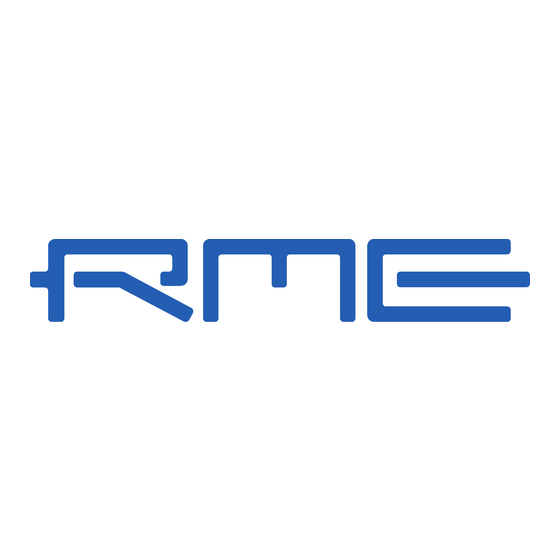Table of Contents
Advertisement
Quick Links
Download this manual
See also:
User Manual
Advertisement
Table of Contents

Summary of Contents for RME Audio DIGI96
- Page 1 User's Guide - Macintosh Version ® ü ü 24 Bit / 96 kHz ® SyncAlign ® PCI Bus Audio Card 2 Channel Stereo Interface 24 Bit / 96 kHz Digital Audio 32-96 kHz Sample Rate Board Rev. 2.1, Hardware version 000...
-
Page 2: Table Of Contents
8.4 Record while Play............ 8 Configuring the DIGI96 9.1 General ..............9 9.2 Clock Modes - Synchronization......10 Using more than one DIGI96 ......11 Special Features of the Digital Output ....12 Operation under ASIO 2.0 12.1 General .............. 13 12.2 Buffer Size - Latency .......... -
Page 3: Introduction
Thank you for choosing a RME product. DIGI96 allows the recording of digital audio from CD, DAT, sampler or other sources directly into your computer. The numerous unique features and well thought-out configuration dialog puts the DIGI96 series at the very top of the range of digital audio interface cards. -
Page 4: Technical Specifications
This mode is active when using the Sound Manager. 16 bit 2 bytes (stereo 4 bytes) 32 bit 4 bytes (stereo 8 bytes) These modes are available when using ASIO. The 32 bit mode is used to provide 24 bit audio resolution. User's Guide DIGI96 © RME... -
Page 5: Hardware Installation
3. Neutralize the static build up by touching the computer's metal-chassis before unpacking the DIGI96 from the protective bag. 4. Insert DIGI96 into a free PCI slot, press and ensure that the card is properly seated. Fa- sten the screw (if any). - Page 6 Driver loading or hardware recognition failed If the DIGI96 driver icon has a red cross through it either driver installation or hardware reco- gnition failed. Try to use a different PCI-slot and check that all driver files are found in the sy- stem folder.
-
Page 7: Operation And Usage
8. Operation and Usage 8.1 Connections The DIGI96 has 2 external and 1 internal (contact pins on the board) inputs and outputs. The internal digital input can be connected to an internal CD-ROM drive when this is supplied with a digital audio output (advantage: the built in CD-ROM drive is sufficient for digital recor- ding and the need for external cabling does not arise). -
Page 8: Digital Record
(or similar) dialog. It often makes sense to monitor the input signal or send it directly to the output. The DIGI96 series includes a useful input monitor function, which can be set in the Settings dialog of the DIGI96 driver (Output/Automatic). -
Page 9: Configuring The Digi96
9. Configuring the DIGI96 9.1 General The hardware of the DIGI96 series includes a number of helpful, well thought-of practical functions and options, which allow to configure the behaviour of the card to suit many different requirements. Through ‘Settings’ you will gain access to:... -
Page 10: Clock Modes - Synchronization
AutoSync allows multiple cards to be easily synchronized by applying one input signal to all inputs simultaneously (see chapter 10). Thanks to the described AutoSync technology and a lightning fast PLL the DIGI96 Series is not only capable of handling standard frequencies, but also any sample rate between 25 and 102 kHz. -
Page 11: Using More Than One Digi96
In order to connect more than one DIGI96 to a digital mixing desk they must all get the same clock(ed input signal). This is easy to achieve: just connect at least one input of each card to one output of the mixing desk. -
Page 12: Special Features Of The Digital Output
Apart from the audio data itself, digital audio signals in SPDIF or AES/EBU format include a header containing Channel Status information. False Channel Status is a common cause of malfunction. The DIGI96 series ignores the received header and creates a totally new one for the output signal. -
Page 13: Operation Under Asio
The Buffer Size value in the RME DIGI Settings dialog determines the latency (in this case the delay) between the audio application and the DIGI96 series as well as general system stability. The higher the value, the more tracks can be recorded and played back simultaneously and the longer the system takes to react. -
Page 14: Performance
In practical terms, this is more than enough to playback more than 30 tracks recorded onto hard disk using Cubase and the DIGI96 series! Working at 96 kHz and 24 bit requires a very fast computer. We recommend at least a G3/400 MHz machine. -
Page 15: Compatibility
In Yosemite boards (G3) cards of the DIGI96 series do not work in slot 11 (next to the graphics card). In Sawtooth boards (G4) cards of the DIGI96 series do not work in slot 2 (B, next to the graphics card). Athough the system recognizes the card correctly as PCI device no adress is assigned (no configuration write access possible). -
Page 16: Troubleshooting
In case the driver icon appears with a red cross after installation of the drivers: Is the Error LED of the DIGI96 lit when no cable is connected to the optical input? If not, the card is either defective or not sitting properly in its slot. -
Page 17: Warranty
RME does not accept claims for damages of any kind, especially consequential damage. Liabi- lity is limited to the value of the DIGI96. The general terms of business drawn up by Synthax OHG apply at all times. - Page 18 Block diagram User's Guide DIGI96 © RME...
- Page 19 In order for an installation of this product to maintain compliance with the limits for a Class B device, shielded cables must be used for the connection of any devices external to this pro- duct. User's Guide DIGI96 © RME...














